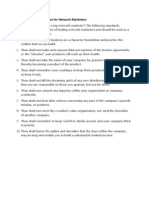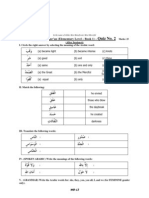Marketing Plan Template and Guide: Business - Gov.au
Marketing Plan Template and Guide: Business - Gov.au
Uploaded by
maheshunCopyright:
Available Formats
Marketing Plan Template and Guide: Business - Gov.au
Marketing Plan Template and Guide: Business - Gov.au
Uploaded by
maheshunOriginal Description:
Original Title
Copyright
Available Formats
Share this document
Did you find this document useful?
Is this content inappropriate?
Copyright:
Available Formats
Marketing Plan Template and Guide: Business - Gov.au
Marketing Plan Template and Guide: Business - Gov.au
Uploaded by
maheshunCopyright:
Available Formats
Marketing plan template and guide
business.gov.au
A good marketing plan helps you identify your customers and competitors and develop a
strategy to make your business stand out. The business.gov.au Marketing Plan template
steps you through the process of creating a solid, well-structured plan tailored to your
business.
New! Create your marketing plan on your tablet by downloading our free
MarketMyBiztabletapp. Visit www.business.gov.au/apps now!
Copies of the latest version of this template and guide can be downloaded from
www.business.gov.au/plans.
If you need further information, assistance or referral about a business issue, please
contact business.gov.au on 13 28 46.
[Business Name] Marketing Plan [YEAR]
How to use this template
Before you complete thismarketing plan template and start using it, consider the
following:
1.
Do your research. You will need to make quite a few decisions about your
business including structure, marketing strategies and finances before you can
complete the template. By having the right information to hand you also can be
more accurate in your forecasts and analysis.
2.
Determine who the plan is for. Does it have more than one purpose? Will it be
used internally or will third parties be involved? Deciding the purpose of the plan
can help you target your answers. If third parties are involved, find out what are
they interested in.
3.
Do not attempt to fill in the template from start to finish. First decide which
Value to customer: [How do your customers view your products/services? Are
they a necessity, luxury or something in between?]
Growth potential: [What is the anticipated percentage growth of the product in the
future? What will drive this growth?]
Sales/marketing personnel
Job Title
Name
Responsibilities
[e.g. Marketing/
Sales Manager]
[Mr Chris Brantley]
[What are the main
responsibilities of this
position?]
[e.g. Marketing/
Sales Manager]
[Mr Chris Brantley]
[What are the main
responsibilities of this
position?]
[e.g. Marketing/
Sales Manager]
[Mr Chris Brantley]
[What are the main
responsibilities of this
position?]
[Business Name] Marketing Plan [YEAR]
The Future
Vision statement
[What is your business' vision statement? It should briefly outline your future plan for the business and include your overall goals.]
Mission statement
[What is your business' mission statement (i.e. how will you achieve your vision)?]
Goals/objectives
[What are your short & long term goals? What activities will you undertake to meet these goals?]
[Business Name] Marketing Plan [YEAR]
The Market
Unique selling position
[How is your business unique in the market?What differentiates your product/service from others in the market? What makes your
business stand out from your competition? What product gap or service need does it fill for your customers?]
Your customers/clients
Customer demographics
[Define who your target customers are and how they behave. You can include age, gender, social status, education and attitudes.What
are their lifestyles, activities, values, needs, interests or opinions? Where are they located?]
Key customers
[Identify your key customers. (These can be large consumers of your products/services or individuals whose satisfaction is key to the
success of your business.) How will you target your products/services to them? How will you deliver your products/services to them?]
Customer management
[How will you maintain a good relationship with your customers? What techniques will you use? How will you keep your customers coming
back? Have you introduced customer service standards?Do you follow any particular code of practice?
Your competitors
[How do you rate agains
arket research you have performed. Is the area experiencing population growth? Are there long-term employers in the area? Is the
region's economy stable? Are there seasonal variations?
What is the size of the market? What recent trends have emerged in the market? What growth potential is available and where do you fit
in? How will the market/customers change when you enter the market? What external factors will affect your customers?]
[Business Name] Marketing Plan [YEAR]
Marketing strategy
[What is your overall marketing strategy?What steps or activities will you undertake to achieve your goals/objectives?]
Marketing activity/milestone
Person
responsible
Date of expected
completion
Cost ($)
Success indicator
[Print advertising, online advertising, mail-out,
giveaway, media release, event, website,
blog/social media, public relations, branding and
artwork, or publications and catalogues.]
[Who is
responsible for
completing this
task?]
[When do you
expect to complete
the marketing
activity?]
[Estimated
cost of
activity.]
[What indicator/ measurement
result will need to be met before
this activity is considered a
success?]
[Print advertising, online advertising, mail-out,
giveaway, media release, event, website,
blog/social media, public relations, branding and
artwork, or publications and catalogues.]
[Who is
responsible for
completing this
task?]
[When do you
expect to complete
the marketing
activity?]
[Estimated
cost of
activity.]
[What indicator/ measurement
result will need to be met before
this activity is considered a
success?]
[Print advertising, online advertising, mail-out,
giveaway, media release, event, website,
blog/social media, public relations, branding and
artwork, or publications and catalogues.]
[Who is
responsible for
completing this
task?]
[When do you
expect to complete
the marketing
activity?]
[Estimated
cost of
activity.]
[What indicator/ measurement
result will need to be met before
this activity is considered a
success?]
[Print advertising, online advertising, mail-out,
giveaway, media release, event, website,
blog/social media, public relations, branding and
artwork, or publications and catalogues.]
[Who is
responsible for
completing this
task?]
[When do you
expect to complete
the marketing
activity?]
[Estimated
cost of
activity.]
[What indicator/ measurement
result will need to be met before
this activity is considered a
success?]
[Business Name] Marketing Plan [YEAR]
Advertising & sales
Advertising and promotional strategy
Planned promotion
/advertising type
Promotional strategy
Expected business improvement
Cost ($)
Target date
[Print media
advertising, online
advertising, SMS,
mail-out, giveaway,
media release, social
media campaign or
event.]
[Why have you decided to use this
promotion/advertising type? How and when
will you use it? What is your strategy behind
this? Who will upkeep your social media
presence?]
[How do you expect it will improve your
business success?]
[Estimat
ed cost
of
activity.]
[e.g. Dec 09]
[Print media
advertising, online
advertising, SMS,
mail-out, giveaway,
media release, social
media campaign or
event.]
[Why have you decided to use this
promotion/advertising type? How and when
will you use it? What is your strategy behind
this? Who will upkeep your social media
presence?]
[How do you expect it will improve your
business success?]
[Estimat
ed cost
of
activity.]
[e.g. Dec 09]
[Print media
advertising, online
advertising, SMS,
mail-out, giveaway,
media release, social
media campaign or
event.]
[Why have you decided to use this
promotion/advertising type? How and when
will you use it? What is your strategy behind
this? Who will upkeep your social media
presence?]
[How do you expect it will improve your
business success?]
[Estimat
ed cost
of
activity.]
[e.g. Dec 09]
[Business Name] Marketing Plan [YEAR]
Planned promotion
/advertising type
Promotional strategy
Expected business improvement
Cost ($)
Target date
[Print media
advertising, online
advertising, SMS,
mail-out, giveaway,
media release, social
media campaign or
event.]
[Why have you decided to use this
promotion/advertising type? How and when
will you use it? What is your strategy behind
this? Who will upkeep your social media
presence?]
[How do you expect it will improve your
business success?]
[Estimat
ed cost
of
activity.]
[e.g. Dec 09]
Social media strategy
[What do you want to achieve/communicate (brand awareness, online sales etc)? What social media tools do your customers use (e.g.
Blogs, Twitter, Facebook etc)? What strategies can you use to network and communicate effectively with these customers?Who will
upkeep your social media presence do you have the internal staff or would you need to engage an external organisation]
Sales strategy
[What sales techniques do you use? What are your strategies behind these techniques? How is this different/better than your
competitors?]
Sales and distribution channels
Channel type
Products/services
Percentage of
sales (%)
Distribution strategy
[e.g. Shopfront,
internet, direct mail,
export or wholesale.]
[List all the
products/services sold
via this channel]
[What percentage
of overall sales do
you expect to sell
via this channel?]
[Why have you decided to use this channel type? How and when
will you use it? What is the strategy behind using this channel type
for this particular product/service?]
[Business Name] Marketing Plan [YEAR]
Channel type
Products/services
Percentage of
sales (%)
Distribution strategy
[e.g. Shopfront,
internet, direct mail,
export or wholesale.]
[List all the
products/services sold
via this channel]
[What percentage
of overall sales do
you expect to sell
via this channel?]
[Why have you decided to use this channel type? How and when
will you use it? What is the strategy behind using this channel type
for this particular product/service?]
[e.g. Shopfront,
internet, direct mail,
export or wholesale.]
[List all the
products/services sold
via this channel]
[What percentage
of overall sales do
you expect to sell
via this channel?]
[Why have you decided to use this channel type? How and when
will you use it? What is the strategy behind using this channel type
for this particular product/service?]
[e.g. Shopfront,
internet, direct mail,
export or wholesale.]
[List all the
products/services sold
via this channel]
[What percentage
of overall sales do
you expect to sell
via this channel?]
[Why have you decided to use this channel type? How and when
will you use it? What is the strategy behind using this channel type
for this particular product/service?]
[Business Name] Marketing Plan [YEAR]
The Finances
[To complete the finances portion of this marketing plan, you should rely heavily on your financial statements and projections. The
business.gov.au Business plan template available at www.business.gov.au/businessplan can provide you with a start-up costing, balance
sheet profit and loss, cash flow and a break-even analysis template.]
Price
[What price have you determined for your products/services? Does this price take into account all your costs including personal, start-up,
operational, cash flow and working capital? Have you also allocated a profit margin in your costing? What price will your target market
bear? Do your prices take into account any seasonal variation to your suppliers costs?]
Expected sales
[What are your expected sales? When do you hope to achieve these figures? Are there seasonal influences?]
[Business Name] Marketing Plan [YEAR]
Marketing budget [YEAR]
[Consider the example below when developing a budget to include in your business plan.]
[Business Name] Marketing Plan [YEAR]
Monitoring/measurement activities
[Reviewing the impact of yourmarketing should be a periodic activity. List the details of each review in the table below.]
Marketing activity
Date of
review
Monitoring methods
Review outcomes
[Print advertising, online
advertising, mail-out,
giveaway, media
release, event, website,
blog/social media, public
relations, branding and
artwork, or publications
and catalogues.]
[e.g.
Month/Year]
[What tools did you use to
measure/monitor the impact
of your marketing activities?]
[What were the results for the promotional period? What were
your sales/profit figures? How many new/repeat customers did
you receive? How many customers visited your website?]
[Print advertising, online
advertising, mail-out,
giveaway, media
release, event, website,
blog/social media, public
relations, branding and
artwork, or publications
and catalogues.]
[e.g.
Month/Year]
[What tools did you use to
measure/monitor the impact
of your marketing activities?]
[What were the results for the promotional period? What were
your sales/profit figures? How many new/repeat customers did
you receive? How many customers visited your website?]
[Print advertising, online
advertising, mail-out,
giveaway, media
release, event, website,
blog/social media, public
relations, branding and
artwork, or publications
and catalogues.]
[e.g.
Month/Year]
[What tools did you use to
measure/monitor the impact
of your marketing activities?]
[What were the results for the promotional period? What were
your sales/profit figures? How many new/repeat customers did
you receive? How many customers visited your website?]
[Business Name] Marketing Plan [YEAR]
Marketing activity
Date of
review
Monitoring methods
Review outcomes
[Print advertising, online
advertising, mail-out,
giveaway, media
release, event, website,
blog/social media, public
relations, branding and
artwork, or publications
and catalogues.]
[e.g.
Month/Year]
[What tools did you use to
measure/monitor the impact
of your marketing activities?]
[What were the results for the promotional period? What were
your sales/profit figures? How many new/repeat customers did
you receive? How many customers visited your website?]
[Business Name] Marketing Plan [YEAR]
Supporting documentation
Attached is my supporting documentation in relation to this business plan. The attached
documents include:
[List all of your attachments here. These may include resumes, customer
survey/questionnaire and/or financial documents.]
Glossary
Australian Business Number (ABN) a single identifying number used when dealing
with other businesses and the Tax Office.
Australian Company Number (ACN) the number allocated by the Australian
Securities and Investments Commission (ASIC) when you register a company under
Corporations Law.
Blog is a shortened word for Weblog (see Weblog).
Channel a way of delivering something to its destination, whether it is a message to
be communicated or a physical product to be delivered.
Contract a legally enforceable agreement made between two or more parties. A
contract may be a verbal contract or a written contract (or may be partly verbal and
partly written).
Demographics the characteristics of a segment of the population, e.g. customers.
Domain name a name that identifies an organisation's address on the internet, either
a website address (the domain name follows the 'www') or an email address (the domain
name follows the '@' symbol in the email address).
Goods and Services Tax (GST) a broad-based tax of 10 per cent on the sale of most
goods and services in Australia.
High-end usually refers to expensive or high quality products/services.
Market position refers to the position an organisation, product or service has in the
market, usually in relation to its competition.
Milestone a goal or objective with a target date.
Mission statement is a statement outlining how an organisation intends on achieving
its vision.
Social
You might also like
- Marketing Plan Template-CIMDocument5 pagesMarketing Plan Template-CIMMina Youssef100% (1)
- CSD RQF Artificial Intelligence: Prepared by Ehsanul HoqueDocument16 pagesCSD RQF Artificial Intelligence: Prepared by Ehsanul Hoqueshabir AhmadNo ratings yet
- Web Security For Software TestingDocument6 pagesWeb Security For Software TestingguruannamalaiNo ratings yet
- Walt DisneyDocument3 pagesWalt Disneyhb_shotgun50% (2)
- Principles of MKTG WN AssgDocument7 pagesPrinciples of MKTG WN AssgShahzada Khayyam NisarNo ratings yet
- 792 1601898451857 UNIT 19 Data Structures and AlgorithmsDocument69 pages792 1601898451857 UNIT 19 Data Structures and AlgorithmsRaishaNo ratings yet
- 2018 Ferentinos, Deep Learning Models For Plant Disease Detection and DiagnosisDocument8 pages2018 Ferentinos, Deep Learning Models For Plant Disease Detection and DiagnosisShahid Amir LakNo ratings yet
- GSM Based Industrial Fault Monitoring Detection System - Microtronics Technologies - Projects of 8051Document2 pagesGSM Based Industrial Fault Monitoring Detection System - Microtronics Technologies - Projects of 8051yogeshm1244404No ratings yet
- Binary Search TreeDocument39 pagesBinary Search TreeBikram Kesharee NayakNo ratings yet
- Type CheckingDocument18 pagesType CheckingsnoopdockNo ratings yet
- Concierge SimplifiedDocument46 pagesConcierge SimplifiedManuj BahalNo ratings yet
- History of Computer Operating SystemsDocument12 pagesHistory of Computer Operating Systemsapi-3695543No ratings yet
- Classroom Management: Three Crucial Areas of Mastery For A New TeacherDocument6 pagesClassroom Management: Three Crucial Areas of Mastery For A New TeacherAnnastassia StewartNo ratings yet
- Question 1: State and Justify The Validity of Following Inference Rules (I) Chain Rule (Ii) SimplificationDocument24 pagesQuestion 1: State and Justify The Validity of Following Inference Rules (I) Chain Rule (Ii) SimplificationAakansha TyagiNo ratings yet
- The Nature of MarketingDocument32 pagesThe Nature of MarketingRajesh KsNo ratings yet
- Section-A 2 Marks Questions (Question 1 To 15) Page (1 To 3)Document36 pagesSection-A 2 Marks Questions (Question 1 To 15) Page (1 To 3)Sam RenuNo ratings yet
- Pros and Cons of Open Source For DevelopersDocument5 pagesPros and Cons of Open Source For DevelopersTimvane Tim C ChabalukaNo ratings yet
- The Ten Commandments For Network MarketersDocument3 pagesThe Ten Commandments For Network MarketersJustin Lloyd Narciso PachecoNo ratings yet
- 1651 GCS0901 NguyenHoaiNam Assignment2Document33 pages1651 GCS0901 NguyenHoaiNam Assignment2nam nguyenNo ratings yet
- Binary Search TreeDocument45 pagesBinary Search TreeAyush KarnNo ratings yet
- Linux File SystemDocument14 pagesLinux File SystemsumanrbrNo ratings yet
- Database TestingDocument4 pagesDatabase TestingVina SinghNo ratings yet
- Sant RahimDocument7 pagesSant RahimAneeta Hani KapoorNo ratings yet
- Marketing MNG NotesDocument119 pagesMarketing MNG NotesShipra AggarwalNo ratings yet
- Network Operating SystemDocument19 pagesNetwork Operating Systemapi-356461439No ratings yet
- Difference Between SSD and HDDDocument2 pagesDifference Between SSD and HDDShivam SinghNo ratings yet
- Le Vo Thang - GCD17011Document19 pagesLe Vo Thang - GCD17011goosam9992100% (1)
- EeeDocument242 pagesEeeMikhaelA.RodriguezNo ratings yet
- Planning For Growth.Document28 pagesPlanning For Growth.Ritik GarodiaNo ratings yet
- Hazrate Khizr - Ek Tehqeeqi Jaaiza (Urdu)Document32 pagesHazrate Khizr - Ek Tehqeeqi Jaaiza (Urdu)Mustafawi PublishingNo ratings yet
- Deletion From A Binary Search TreeDocument10 pagesDeletion From A Binary Search TreeChirag SheokandNo ratings yet
- Solutions For A Changing WorldDocument16 pagesSolutions For A Changing WorldAl BruceNo ratings yet
- Business Intelligence: Milan TripathiDocument43 pagesBusiness Intelligence: Milan Tripathimil100% (1)
- Bajrang Baan-Hanumaan JiDocument5 pagesBajrang Baan-Hanumaan JiArun SharmaNo ratings yet
- Ecommerce Website ProposalDocument7 pagesEcommerce Website ProposalAshish JainNo ratings yet
- SUMMARY: Organizations Have Various Objectives in Utilizing Social Media, FromDocument3 pagesSUMMARY: Organizations Have Various Objectives in Utilizing Social Media, Fromjas_4u1989No ratings yet
- Key Account ManagementDocument3 pagesKey Account Managementadedoyin123No ratings yet
- Freelancer: Get To Work, Grow Your CareerDocument24 pagesFreelancer: Get To Work, Grow Your CareerFaizanNo ratings yet
- DropboxDocument3 pagesDropboxmeriemNo ratings yet
- Compiler Construction II HandoutDocument27 pagesCompiler Construction II HandoutWest100% (1)
- Neck DesignDocument7 pagesNeck Designjogalbhushan0% (1)
- Quran Quiz 2Document1 pageQuran Quiz 2elbee_2k921No ratings yet
- Basics of SEO: by SeoexonDocument30 pagesBasics of SEO: by SeoexonSeoexonNo ratings yet
- Digital Marketing Course BrochureDocument18 pagesDigital Marketing Course Brochuredigital sridharNo ratings yet
- Freelancer's Guide: Get To Work, Grow Your Business, and Do What Matters To YouDocument33 pagesFreelancer's Guide: Get To Work, Grow Your Business, and Do What Matters To YouAl JaberNo ratings yet
- Facebook Ads Reports: Product & Optimization GuideDocument9 pagesFacebook Ads Reports: Product & Optimization GuideAndreea AdamNo ratings yet
- Real Estate Digital MarketingDocument3 pagesReal Estate Digital MarketingValaina FrancisNo ratings yet
- Brand Positioning Is All About Owning A Space in The Consumers' Mind and Create ADocument3 pagesBrand Positioning Is All About Owning A Space in The Consumers' Mind and Create ARajat ChawlaNo ratings yet
- Get Response Devjeet KaurDocument15 pagesGet Response Devjeet KaurDevjeet KaurNo ratings yet
- Graph Theory Final 1Document48 pagesGraph Theory Final 1anupama sureshNo ratings yet
- Website ProposalDocument10 pagesWebsite ProposalVanessa Simpson100% (1)
- An Analysis To BPSC PT With Solved 2011 Question PaperDocument42 pagesAn Analysis To BPSC PT With Solved 2011 Question PaperFillipa PedagogicsNo ratings yet
- What Are The 7 Types of Digital MarketingDocument9 pagesWhat Are The 7 Types of Digital Marketinggfx100% (1)
- Hadees Ki Mashoor KitabenDocument306 pagesHadees Ki Mashoor KitabenMushtaq55No ratings yet
- SynopsisDocument12 pagesSynopsisTony HobbsNo ratings yet
- Koinswap WhitepaperDocument25 pagesKoinswap WhitepaperRizen btrNo ratings yet
- CV of Shahriar TariqDocument3 pagesCV of Shahriar TariqKidFromDhakaNo ratings yet
- Marketing Plan TemplateDocument4 pagesMarketing Plan TemplateMOORTHY.KE100% (9)
- Marketing Plan TemplateDocument5 pagesMarketing Plan TemplateRohith Sharma100% (1)
- Agency Brief Template - B2BDocument7 pagesAgency Brief Template - B2BEmily PhilippouNo ratings yet
- Final Expense Agent Training ManualDocument18 pagesFinal Expense Agent Training ManualMin Shein Maung MaungNo ratings yet
- Distribution & Retail ManagementDocument65 pagesDistribution & Retail ManagementParan DeshmukhNo ratings yet
- Kewirausahaan Zhidan Yanuar PamungkasDocument15 pagesKewirausahaan Zhidan Yanuar Pamungkaszhidan yanuarNo ratings yet
- 2019 Business Plan 8th PlaceDocument30 pages2019 Business Plan 8th PlaceJanella MendozaNo ratings yet
- Unit 4 - Marketing Mix PDFDocument7 pagesUnit 4 - Marketing Mix PDFlovellmenezes100% (4)
- CH1L3 Traditional and Contemporary MarketingDocument20 pagesCH1L3 Traditional and Contemporary MarketingFranciz Panganiban0% (1)
- Unit 6 PPT 2Document28 pagesUnit 6 PPT 2m49dgxk9bwNo ratings yet
- Competitive Analysis of Zomato and Swiggy: Personal DetailsDocument58 pagesCompetitive Analysis of Zomato and Swiggy: Personal Details148 Kanchan SasaneNo ratings yet
- Chapter - Ii Company Profile: 2.1 MarketDocument13 pagesChapter - Ii Company Profile: 2.1 MarketsabidNo ratings yet
- Unit 2:: Advertising AgencyDocument7 pagesUnit 2:: Advertising AgencyMansi Sharma100% (1)
- Advertising in Tamil Nadu Cable TV Channels: Contact 9498022026Document6 pagesAdvertising in Tamil Nadu Cable TV Channels: Contact 9498022026Apple AdsNo ratings yet
- The Ultimate Selling Story by Roy FurrDocument80 pagesThe Ultimate Selling Story by Roy FurrLuongTrungThanh91% (11)
- Associate Creative Director Marketing in NYC NY Resume Elaine AshburnDocument2 pagesAssociate Creative Director Marketing in NYC NY Resume Elaine AshburnElaineAshburnNo ratings yet
- E-Marketing: MBA 7607 - Managing E-BusinessDocument50 pagesE-Marketing: MBA 7607 - Managing E-BusinessPrateek Parkash100% (2)
- HybridDocument11 pagesHybridkevinboby007No ratings yet
- Case Analysis - AvonDocument6 pagesCase Analysis - Avonnk_1234No ratings yet
- Chapter 14 - Direct - Online Marketing-Building Direct Customer RelationshipsDocument28 pagesChapter 14 - Direct - Online Marketing-Building Direct Customer RelationshipsMin Shi TanNo ratings yet
- PERCEIVED PROMOTIONAL MIXED OF Retail STORE IN NAVAL BILIRRANDocument24 pagesPERCEIVED PROMOTIONAL MIXED OF Retail STORE IN NAVAL BILIRRANAlaiza EstradaNo ratings yet
- DM Company Project ManagementDocument7 pagesDM Company Project ManagementPuneeth SuNo ratings yet
- Toyota Pakistan...... Research Report On Sales ManagementDocument22 pagesToyota Pakistan...... Research Report On Sales ManagementAkbar Syed100% (1)
- Marketing Activities Huyen Tran..Document2 pagesMarketing Activities Huyen Tran..Tuyền Nguyễn Thị ThúyNo ratings yet
- Direct Marketing in ActionDocument233 pagesDirect Marketing in ActionSangram100% (5)
- Imc 3-5Document27 pagesImc 3-5beth elNo ratings yet
- Promotional ToolsDocument36 pagesPromotional ToolsKyla LimNo ratings yet
- PermissionDocument9 pagesPermissionMohamad Rendi NafirahmanNo ratings yet
- CH14 (Direct, Online, Social Media, and Mobile Marketing) (Out)Document18 pagesCH14 (Direct, Online, Social Media, and Mobile Marketing) (Out)business doc100% (1)
- Digital Age PRDocument28 pagesDigital Age PRMoatasem Hatem100% (2)
- Chapter 1Document43 pagesChapter 1Sheri DeanNo ratings yet
- Big BazaarDocument19 pagesBig BazaarHamid KhanNo ratings yet
- Presentation: Direct Marketing & Its FunctionDocument12 pagesPresentation: Direct Marketing & Its FunctionAkriti Jaiswal100% (1)

























































































